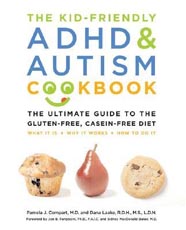 Excerpt
from The Kid-Friendly ADHD & Autism Cookbook: The Ultimate Guide to the Gluten-Free, Casein-Free Diet
Excerpt
from The Kid-Friendly ADHD & Autism Cookbook: The Ultimate Guide to the Gluten-Free, Casein-Free Diet
by Pamela J. Compart, M.D. and Dana Laake, R.D.H., M.S., L.D.N.
Picky Appetites, Texture Issues,
and
Odd Food Choices
There are many reasons why children develop these picky appetites. Many children, not just children with autism, are deficient in zinc. Zinc is a critically important nutrient in the body. One important consequence of zinc deficiency is a change in taste and smell. The taste of a food is what makes eating pleasurable. If you are unable to taste or smell a food the main sensation you would be aware of when eating the food is its texture. You can well imagine that, at best, this would not be as enjoyable, and at worst, this could be unpleasant or intolerable. Many of us have also likely experienced a negative response to a food, such as developing food poisoning. These types of "sense memories" can be strong, resulting in a complete lack of desire for that food for a long time, even if you can logically convince yourself that the reaction was a fluke or the result of a specific situation. This is important to remember because even when zinc deficiencies are corrected and taste normalizes, there may be a strong behavioral component to avoidance of specific foods that may need to be addressed. Often the best treatment is time and patience, though in severe situations, specific feeding therapy interventions may be needed.
As previously described, opiate-like reactions from food can also lead to picky appetites. Children may not know why they are choosing particular foods; they may simply be responding to an awareness that certain foods make their brain feel good. They may then want to eat only those foods, either due to a physically based craving for those foods or to an "addiction" to the pleasurable feelings they get from them. Once this addiction is broken--either by eliminating those foods from the diet or by digesting them more efficiently (through the use of digestive enzymes)-children's dietary choices may broaden.
A large number of children with autism and a subset of children with ADHD also have a condition known as sensory integration dysfunction or sensory processing disorder. This refers to problems handling the variety of sensations that bombard our bodies everyday. We sense the environment through touch, sound, smell, taste, and movement. In some children, these senses are heightened, so that sounds that don't typically bother people are too loud, or smells are too strong. If severe enough, this can actually be painful for children. Related to eating, if a child does not process taste or smell or touch normally, foods may be very unpleasant. Mild tastes may seem strong, mild smells may be overwhelming, or particular textures may be intolerable. In these cases, occupational therapy can be helpful to normalize a child's ability to process sensory feelings in a more normal and tolerable way.
Withdrawal Symptoms from Foods - How Can This Be?
Some children, especially those who are making opiate-like peptides from their foods, are actually physically addicted to those foods. When the foods are removed from the diet, they can experience symptoms that are similar to drug withdrawal. The most common symptoms are irritability and sometimes anger or rage. Children may also temporarily regress their behavior or in their developmental skills. Withdrawal symptoms can actually be viewed as a good sign, as this indicates the foods were having some effect on the child. Anytime there are negative symptoms from removing a food from the diet, the food is a problem. Not having withdrawal symptoms does not necessarily mean the food is not a problem. Some children have resilient personalities and bodies and can tolerate withdrawal symptoms well, without obvious side effects.
Some children can tolerate abrupt removal of the offending foods. However, most do best with gradual removal of the foods, as this allows their body to adjust with fewer side effects. From a practical standpoint, gradual withdrawal is usually a necessity if your child is a picky eater, as you need to find substitute foods your child is actually willing to eat.
The above is an excerpt from the book The Kid-Friendly ADHD & Autism Cookbook: The Ultimate Guide to the Gluten-Free, Casein-Free Diet
by Pamela J. Compart, M.D. and Dana Laake, R.D.H., M.S., L.D.N.
Published by Fair Winds Press; November 2006;$24.95US/$32.50CAN; 978-1-59233-223-6
Copyright © 2008 Pamela J. Compart, M.D. and Dana Laake, R.D.H., M.S., L.D.N
